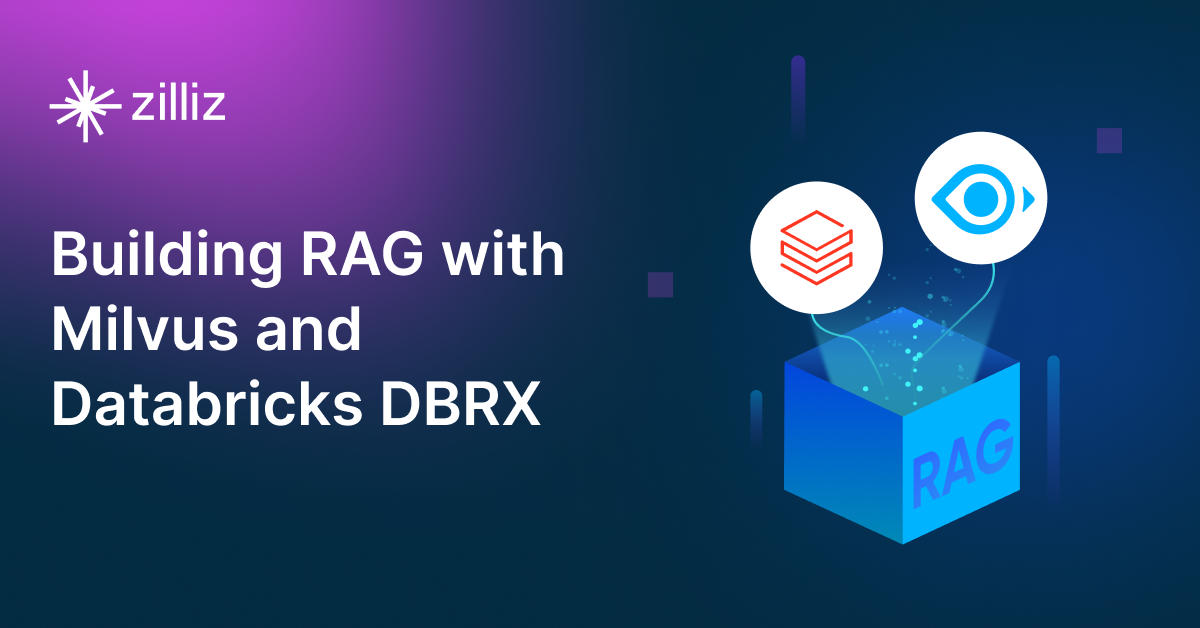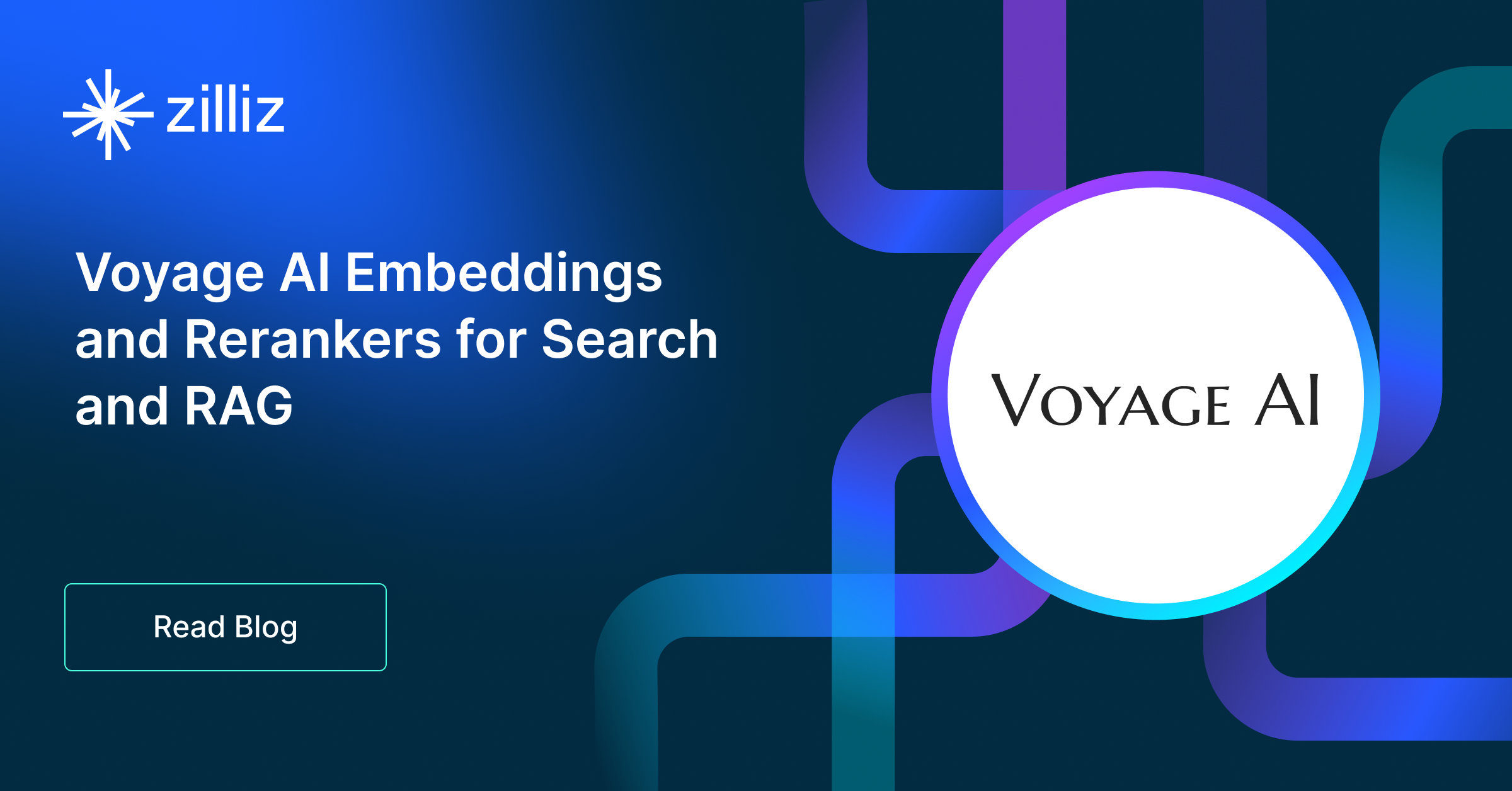Build RAG Chatbot with LangChain, Milvus, Anthropic Claude 3.5 Sonnet, and nomic-embed-text-v1.5
Introduction to RAG
Retrieval-Augmented Generation (RAG) is a game-changer for GenAI applications, especially in conversational AI. It combines the power of pre-trained large language models (LLMs) like OpenAI’s GPT with external knowledge sources stored in vector databases such as Milvus and Zilliz Cloud, allowing for more accurate, contextually relevant, and up-to-date response generation. A RAG pipeline usually consists of four basic components: a vector database, an embedding model, an LLM, and a framework.
Key Components We'll Use for This RAG Chatbot
This tutorial shows you how to build a simple RAG chatbot in Python using the following components:
- LangChain: An open-source framework that helps you orchestrate the interaction between LLMs, vector stores, embedding models, etc, making it easier to integrate a RAG pipeline.
- Milvus: An open-source vector database optimized to store, index, and search large-scale vector embeddings efficiently, perfect for use cases like RAG, semantic search, and recommender systems. If you hate to manage your own infrastructure, we recommend using Zilliz Cloud, which is a fully managed vector database service built on Milvus and offers a free tier supporting up to 1 million vectors.
- Anthropic Claude 3.5 Sonnet: This advanced model in the Claude 3 family is designed for nuanced understanding and creative language generation. With enhanced prompt comprehension and contextual awareness, it excels in complex dialogue, creative writing, and sophisticated content creation. Ideal for applications where deep engagement and high-quality output are paramount.
- nomic-embed-text-v1.5: This model specializes in generating high-quality text embeddings that capture semantic meaning and contextual nuances. Its strength lies in facilitating efficient similarity search and information retrieval tasks. Ideal for applications in recommendation systems, semantic search, and natural language understanding, it enhances performance in various NLP projects.
By the end of this tutorial, you’ll have a functional chatbot capable of answering questions based on a custom knowledge base.
Note: Since we may use proprietary models in our tutorials, make sure you have the required API key beforehand.
Step 1: Install and Set Up LangChain
%pip install --quiet --upgrade langchain-text-splitters langchain-community langgraph
Step 2: Install and Set Up Anthropic Claude 3.5 Sonnet
pip install -qU "langchain[anthropic]"
import getpass
import os
if not os.environ.get("ANTHROPIC_API_KEY"):
os.environ["ANTHROPIC_API_KEY"] = getpass.getpass("Enter API key for Anthropic: ")
from langchain.chat_models import init_chat_model
llm = init_chat_model("claude-3-5-sonnet-latest", model_provider="anthropic")
Step 3: Install and Set Up nomic-embed-text-v1.5
pip install -qU langchain-nomic
import getpass
import os
if not os.environ.get("NOMIC_API_KEY"):
os.environ["NOMIC_API_KEY"] = getpass.getpass("Enter API key for Nomic: ")
from langchain_nomic import NomicEmbeddings
embeddings = NomicEmbeddings(model="nomic-embed-text-v1.5")
Step 4: Install and Set Up Milvus
pip install -qU langchain-milvus
from langchain_milvus import Milvus
vector_store = Milvus(embedding_function=embeddings)
Step 5: Build a RAG Chatbot
Now that you’ve set up all components, let’s start to build a simple chatbot. We’ll use the Milvus introduction doc as a private knowledge base. You can replace it with your own dataset to customize your RAG chatbot.
import bs4
from langchain import hub
from langchain_community.document_loaders import WebBaseLoader
from langchain_core.documents import Document
from langchain_text_splitters import RecursiveCharacterTextSplitter
from langgraph.graph import START, StateGraph
from typing_extensions import List, TypedDict
# Load and chunk contents of the blog
loader = WebBaseLoader(
web_paths=("https://milvus.io/docs/overview.md",),
bs_kwargs=dict(
parse_only=bs4.SoupStrainer(
class_=("doc-style doc-post-content")
)
),
)
docs = loader.load()
text_splitter = RecursiveCharacterTextSplitter(chunk_size=1000, chunk_overlap=200)
all_splits = text_splitter.split_documents(docs)
# Index chunks
_ = vector_store.add_documents(documents=all_splits)
# Define prompt for question-answering
prompt = hub.pull("rlm/rag-prompt")
# Define state for application
class State(TypedDict):
question: str
context: List[Document]
answer: str
# Define application steps
def retrieve(state: State):
retrieved_docs = vector_store.similarity_search(state["question"])
return {"context": retrieved_docs}
def generate(state: State):
docs_content = "\n\n".join(doc.page_content for doc in state["context"])
messages = prompt.invoke({"question": state["question"], "context": docs_content})
response = llm.invoke(messages)
return {"answer": response.content}
# Compile application and test
graph_builder = StateGraph(State).add_sequence([retrieve, generate])
graph_builder.add_edge(START, "retrieve")
graph = graph_builder.compile()
Test the Chatbot
Yeah! You've built your own chatbot. Let's ask the chatbot a question.
response = graph.invoke({"question": "What data types does Milvus support?"})
print(response["answer"])
Example Output
Milvus supports various data types including sparse vectors, binary vectors, JSON, and arrays. Additionally, it handles common numerical and character types, making it versatile for different data modeling needs. This allows users to manage unstructured or multi-modal data efficiently.
Optimization Tips
As you build your RAG system, optimization is key to ensuring peak performance and efficiency. While setting up the components is an essential first step, fine-tuning each one will help you create a solution that works even better and scales seamlessly. In this section, we’ll share some practical tips for optimizing all these components, giving you the edge to build smarter, faster, and more responsive RAG applications.
LangChain optimization tips
To optimize LangChain, focus on minimizing redundant operations in your workflow by structuring your chains and agents efficiently. Use caching to avoid repeated computations, speeding up your system, and experiment with modular design to ensure that components like models or databases can be easily swapped out. This will provide both flexibility and efficiency, allowing you to quickly scale your system without unnecessary delays or complications.
Milvus optimization tips
Milvus serves as a highly efficient vector database, critical for retrieval tasks in a RAG system. To optimize its performance, ensure that indexes are properly built to balance speed and accuracy; consider utilizing HNSW (Hierarchical Navigable Small World) for efficient nearest neighbor search where response time is crucial. Partitioning data based on usage patterns can enhance query performance and reduce load times, enabling better scalability. Regularly monitor and adjust cache settings based on query frequency to avoid latency during data retrieval. Employ batch processing for vector insertions, which can minimize database lock contention and enhance overall throughput. Additionally, fine-tune the model parameters by experimenting with the dimensionality of the vectors; higher dimensions can improve retrieval accuracy but may increase search time, necessitating a balance tailored to your specific use case and hardware infrastructure.
Anthropic Claude 3.5 Sonnet optimization tips
Claude 3.5 Sonnet delivers enhanced reasoning while maintaining a balance between speed and complexity. Optimize by refining retrieval pipelines to prioritize top-ranked context, reducing unnecessary token consumption. Use adaptive chunking methods to provide structured and concise context, ensuring that the model receives only the most relevant information. Implement a dynamic query selection approach, routing simpler questions to Claude 3.5 Haiku for cost and speed efficiency while reserving Sonnet for deeper reasoning. Optimize API request handling with batch processing and response caching to lower latency. Fine-tune temperature and sampling settings, keeping them low for deterministic outputs in retrieval-based tasks. Use system instructions to guide responses, improving consistency and reducing hallucinations. If deploying at scale, leverage parallel query execution and real-time monitoring to dynamically adjust workloads based on system performance metrics.
nomic-embed-text-v1.5 optimization tips
nomic-embed-text-v1.5 is a well-rounded embedding model that performs effectively in diverse text retrieval scenarios. Optimize text preprocessing by removing stop words and redundant information before embedding to improve storage efficiency. Use hierarchical indexing structures to manage embeddings in large-scale datasets, improving retrieval speed. Leverage cosine similarity filtering to refine search results post-query. For cost-effective scaling, batch embed multiple documents at once and store embeddings in a distributed vector database like Milvus or FAISS. If dealing with rapidly changing data, implement incremental indexing rather than full reprocessing to save computation time. Regularly monitor embedding quality by validating against a benchmarked dataset to ensure relevance.
By implementing these tips across your components, you'll be able to enhance the performance and functionality of your RAG system, ensuring it’s optimized for both speed and accuracy. Keep testing, iterating, and refining your setup to stay ahead in the ever-evolving world of AI development.
RAG Cost Calculator: A Free Tool to Calculate Your Cost in Seconds
Estimating the cost of a Retrieval-Augmented Generation (RAG) pipeline involves analyzing expenses across vector storage, compute resources, and API usage. Key cost drivers include vector database queries, embedding generation, and LLM inference.
RAG Cost Calculator is a free tool that quickly estimates the cost of building a RAG pipeline, including chunking, embedding, vector storage/search, and LLM generation. It also helps you identify cost-saving opportunities and achieve up to 10x cost reduction on vector databases with the serverless option.
 Calculate your RAG cost
Calculate your RAG cost
What Have You Learned?
What Have You Learned?
Wow, what a journey it’s been! Throughout this tutorial, you’ve unlocked the powerful synergy of a framework, vector database, LLM, and embedding model to construct a cutting-edge Retrieval-Augmented Generation (RAG) system. You’ve witnessed firsthand how the framework, like LangChain, expertly orchestrates the interaction between components, allowing for smooth data flow and integration—making your projects not just possible, but efficient and effective!
With Milvus as your trusty vector database, you’ve seen how it can rapidly power searches, retrieving relevant information in the blink of an eye. Isn’t that exhilarating? From there, Anthropic Claude 3.5 Sonnet has added a new layer of conversational intelligence, allowing your applications not only to respond but to engage in dialogue, making human-computer interactions truly dynamic. And let’s not forget the nomic-embed-text-v1.5 embedding model, which enriched your data with vivid, semantic representations that bring remarkable depth to your system’s understanding.
Plus, those handy optimization tips and a free cost calculator are little treasures to help you refine your designs and stay mindful of your resources. So, what’s next? The sky's the limit! Now that you’re equipped with this knowledge and these tools, it's time to roll up your sleeves and start building, optimizing, and innovating your very own RAG applications. Dive in, explore, and let your creativity flow—amazing things are waiting to be discovered in your capable hands!
Further Resources
🌟 In addition to this RAG tutorial, unleash your full potential with these incredible resources to level up your RAG skills.
- How to Build a Multimodal RAG | Documentation
- How to Enhance the Performance of Your RAG Pipeline
- Graph RAG with Milvus | Documentation
- How to Evaluate RAG Applications - Zilliz Learn
- Generative AI Resource Hub | Zilliz
We'd Love to Hear What You Think!
We’d love to hear your thoughts! 🌟 Leave your questions or comments below or join our vibrant Milvus Discord community to share your experiences, ask questions, or connect with thousands of AI enthusiasts. Your journey matters to us!
If you like this tutorial, show your support by giving our Milvus GitHub repo a star ⭐—it means the world to us and inspires us to keep creating! 💖
- Introduction to RAG
- Key Components We'll Use for This RAG Chatbot
- Step 1: Install and Set Up LangChain
- Step 2: Install and Set Up Anthropic Claude 3.5 Sonnet
- Step 3: Install and Set Up nomic-embed-text-v1.5
- Step 4: Install and Set Up Milvus
- Step 5: Build a RAG Chatbot
- Optimization Tips
- RAG Cost Calculator: A Free Tool to Calculate Your Cost in Seconds
- What Have You Learned?
- Further Resources
- We'd Love to Hear What You Think!
Content
Vector Database at Scale
Zilliz Cloud is a fully-managed vector database built for scale, perfect for your RAG apps.
Try Zilliz Cloud for Free


